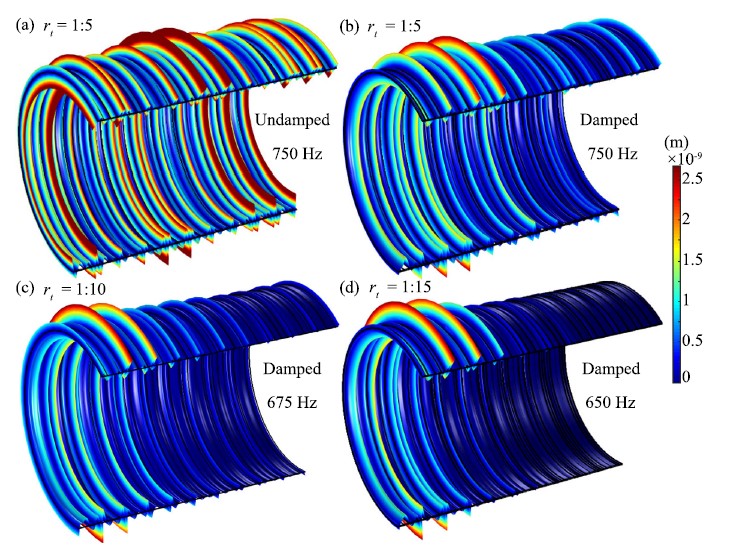Reduction of Bloch-Floquet bending waves via annular acoustic black holes in periodically supported cylindrical shell structures

In this study made by researchers from the GTM, La Salle-URL, in collaboration with researchers at the Laboratoire Vibrations-Acoustique of the INSA-Lyon (France) and at the Chonqing University (China), we have numerically investigated the effect of embedding annular acoustic black holes (ABH) on cylindrical shells. In particular, we have shown how it is possible to achieve significant reduction of the Bloch-Floquet bending waves excited on a periodically supported cylindrical shell by means of the ABH effect. Annular ABHs open the door to new passive vibration and noise emission reduction in typical naval and aerospace structures.
Details on this research can be found in the paper:
Jie Deng, Oriol Guasch, Laurent Maxit and Ling Zheng (2020), "Reduction of Bloch-Floquet bending waves via annular acoustic black holes in periodically supported cylindrical shell structures". Applied Acoustics, 169, 107424.
(https://www.sciencedirect.com/science/article/abs/pii/S0003682X20305284)
with abstract:
In recent years, acoustic black holes (ABHs) have revealed as a very effective method for the passive reduction of vibrations in flat plates and straight beams. Those essentially consist of circular indentations and/or side boundaries, whose thicknesses decrease to zero following a power-law profile. Nonetheless, many structures in the aeronautical and naval sectors, among others, involve cylindrical structures with periodic stiffeners or supports. Such periodic structures admit the propagation of Bloch-Floquet (BF) bending waves at some frequency passbands, which may result in strong vibration levels and noise radiation. In this work, we propose the design of annular ABHs to mitigate the problem. A wave finite element model is first used to determine the frequency passbands on an ideal, periodically simply supported cylindrical shell of infinite length, with embedded annular ABHs. Then, a long, but now finite simply supported cylindrical shell is presented to show how the transmissibility between two sections strongly diminishes with the inclusion of ABHs. That confirms annular ABHs as a very effective means of reducing BF wave propagation. Unfortunately, embedding ABHs on the shell weakens its structural rigidity so a thorough analysis is made on the effects of inserting stiffeners in the longitudinal direction to partially remedy that inconvenient. Quite surprisingly, it is shown that the inclusion of stiffeners can even enhance the performance of the ABHs for some configurations. To finally foresee the potential of annular ABHs for practical applications, a finite element simulation is made on a slightly more realistic geometry, resembling a very simplified version of the hull of a submarine vehicle or a gas tank.
